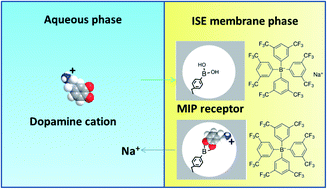A molecularly imprinted polymer-based potentiometric sensor based on covalent recognition for the determination of dopamine†
Abstract
Polymeric membrane potentiometric sensors based on molecularly imprinted polymers (MIPs) have been successfully designed for the detection of organic compounds both in ionic and neutral forms. However, most of these sensors are based on the non-covalent recognition interactions between the functional groups of the MIP in the polymeric sensing membrane and the target. These weak non-covalent interactions are unfavorable for the detection of hydrophilic organic compounds (e.g., dopamine). Herein novel MIP potentiometric sensor based covalent recognition for the determination of protonated dopamine is described. Uniform-sized boronate-based MIP beads are utilized as the recognition receptors. These receptors can covalently bind with dopamine with a cis-diol group to form a five-membered cyclic ester and thus provide a higher affinity because of the stronger nature of the covalent bonds. It has been found that the proposed electrode shows an excellent sensitivity towards dopamine with a detection limit of 2.1 μM, which could satisfy the needs for in vivo analysis of dopamine in the brain of living animals. We believe that the covalent recognition MIP-based sensing strategy provides an appealing way to design MIP-based electrochemical and optical sensors with excellent sensing properties.

- This article is part of the themed collection: Analytical Methods HOT Articles 2021


 Please wait while we load your content...
Please wait while we load your content...